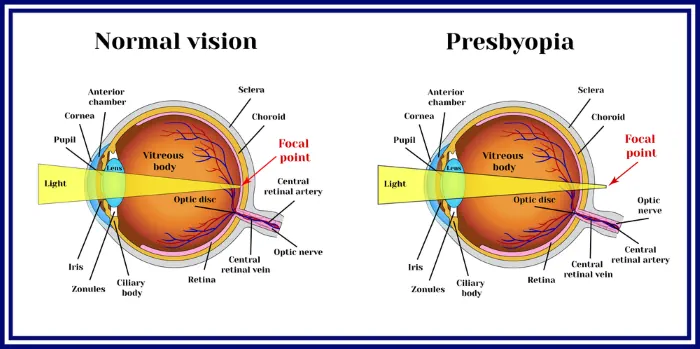Ever put on your glasses one morning and thought, “Hmm, something doesn’t feel right”? Maybe the words on your morning newspaper were blurrier, or the birds in the trees seemed less defined.
It’s not just you – eyeglass prescriptions can and do change. In this post, we’re going to untangle the ‘why’ behind those changes, and give you some tips on what to do next.
(This page contains affiliate links. OGR may receive compensation if you click a link and make a purchase.)
Causes of Eyeglass Prescription Changes
Let’s have a chat about what causes our trusty specs to start letting us down. Knowing the “why” behind the changes can help us keep our eyes in the best condition possible and make more informed decisions about our eyewear.
Age

Just like the rest of our bodies, as we age, our eyes naturally undergo changes. These changes can affect our vision and, as a result, necessitate changes in our eyeglass prescription.
The most common age-related change in vision is presbyopia. Presbyopia is a condition that makes it harder to see objects up close.
It’s caused by the lens of our eye becoming less flexible. This inflexibility means the eye can’t adjust focus as easily as it once could.
Most adults past the age of 40 will start to notice the effects of presbyopia. It’s easy to remedy with a pair of reading glasses.
Refractive Errors
Refractive errors are like the mischievous cousins in the vision family. These errors happen when light doesn’t focus correctly on the retina, which can lead to blurry vision.
The most common culprits here are farsightedness, nearsightedness, and astigmatism.
- Farsightedness (or hyperopia, if you want to get technical) occurs when the eye is too short from front to back. This causes light to focus in front of the retina instead of on it.
- Nearsightedness (also known as myopia) is the opposite – it’s when the eye is too long from front to back, which causes light to focus behind the retina rather than on it.
- Astigmatism is like the wild card of the group. It’s a condition in which the cornea (the clear front part of the eye) isn’t perfectly round. This results in light focusing in several places on the retina instead of just one spot.
Eye Diseases

Our eyes can also be affected by various diseases, which can bring about changes in our vision and subsequently lead to changes in our eyeglass prescription.
Some of the most common vision-impacting diseases are cataracts, glaucoma, and macular degeneration.
- Cataracts cause the lens in the eye to become clouded over. They’re like a foggy window that can cause blurry vision, glare, and those annoying halos around lights.
- Glaucoma is not just one, but a group of eye diseases that can damage the optic nerve. This often results in the loss of peripheral vision.
- Macular degeneration is a condition that damages the macula, the part of the retina responsible for central vision. This can lead to blurry vision, distorted vision, and blind spots.
Other Factors
Apart from the reasons mentioned above, some other factors can lead to changes in vision and, in turn, changes in your eyeglass prescription:
- Diabetes
- Pregnancy (because, let’s face it, growing another human can really shake things up!)
- Head injuries
- Certain medications
What to Do If Your Eyeglass Prescription Changes

First off, if you even slightly suspect that your vision is playing tricks on you, it’s time to pay your eye doctor a visit. This isn’t a time for guesswork, my friend.
Depending on the doctor’s assessment, you might be in for a prescription update. This could mean a shiny new pair of glasses or a fresh set of contact lenses (or both if you like to mix things up).
Now, who doesn’t love a valid reason to shop for some trendy new eyewear?
Here’s another nugget of wisdom: don’t wait for your vision to throw a curveball to schedule an eye exam.
Regular eye exams are essential to maintaining optimal eye health.
You might not notice anything wrong, but it’s still essential to get it checked to ensure everything’s running smoothly.
Frequently Asked Questions
What Can I Do To Prevent Changes In My Vision?
While there isn’t a magic potion to prevent changes in vision, there are some proactive steps you can take to reduce your risk:
- Get regular eye exams: Like your favorite TV show, never miss an episode (or an appointment).
- Maintain a healthy diet: Leafy greens, fruits, lean proteins, and omega-3 rich fish are a feast for your eyes.
- Exercise regularly: Breaking a sweat is not only good for your waistline but also your peepers.
- Quit smoking: It’s no secret that smoking is bad for pretty much every part of your body.
- Wear sunglasses: Wear 100% UV-blocking shades to protect your eyes from harmful sun rays when you’re out and about.
How Much Change In Eye Prescription Is Normal?
The “normal” change in an eye prescription can vary for different people.
But as a rule of thumb, a change of up to 0.50 diopters per year is considered typical.
If you’re seeing a bigger shift than this, make sure to get in touch with your eye doctor to rule out any underlying eye conditions.
Why Did My Glasses Prescription Get Better?
You might be startled if your vision not only didn’t get worse, but actually got better. This can happen for various reasons, such as changes in your eye shape, cornea, lens, or muscles.
Another possibility is that your eyes have simply stopped changing.
Or perhaps you’ve been taking steps to improve your vision and overall health, such as wearing sunglasses when outdoors, eating a healthy diet, and exercising regularly.
Finally, it’s also possible that your previous refractive test was inaccurate and overcorrected more than necessary.
What Is A Significant Change in Eyeglass Prescription?
A significant change in eyeglass prescription is one that affects your vision quality and comfort significantly.
For example, a change of 0.25 diopters may not be noticeable for some people, while a change of 0.50 diopters or more may make a big difference for others.
The significance of a change can also hinge on the type of correction needed—be it sphere, cylinder, axis, or add.
A substantial shift in any of these components can influence how well you see at various distances or angles.